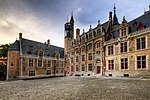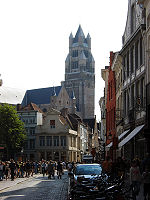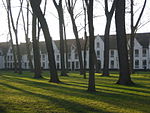Church of Our Lady, Bruges

The Church of Our Lady (Dutch: Onze-Lieve-Vrouwekerk) is a Roman Catholic church in Bruges, Belgium, dating mainly from the 13th, 14th and 15th centuries. Its 115.6-metre-high (379 ft) tower remains the tallest structure in the city and the third tallest brickwork tower in the world (after St. Mary's Church in Lübeck and St. Martin's Church in Landshut, both in Germany). The church demonstrates the Gothic style in the prominent Flying buttresses on the exterior which were constructed in the 1270s and 80s. The nave contains cross-vaults and black and white tiled flooring. The interior demonstrates the heavily ornamented Baroque style in the side aisles and chancel. One of the chapels in the church was created in 1482 for a wealthy man named Lodewijk van Gruuthuse, as his personal worship area.
Excerpt from the Wikipedia article Church of Our Lady, Bruges (License: CC BY-SA 3.0, Authors, Images).Church of Our Lady, Bruges
Mariastraat, Bruges Brugge-Centrum (Brugge)
Geographical coordinates (GPS) Address External links Nearby Places Show on map
Geographical coordinates (GPS)
| Latitude | Longitude |
|---|---|
| N 51.204722222222 ° | E 3.2244444444444 ° |
Address
Onze-Lieve-Vrouwekerk
Mariastraat
8000 Bruges, Brugge-Centrum (Brugge)
West Flanders, Belgium
Open on Google Maps











